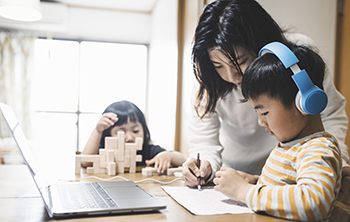Distance learning for children with autism and ADHD: challenges and optimism
Patricia Schetter’s youngest son is a high school senior, attending classes online like so many students this year due to COVID-19.
Distance learning is a challenge for some students with autism, but there’s optimism, too.
“He’s like, ‘Mom, I just want to go back to school. I want to be on campus with my friends,’ ” said Schetter, the coordinator of autism education initiatives for the Center for Excellence in Developmental Disabilities at the UC Davis MIND Institute. “I think even the kids are recognizing that though this is necessary right now, it may not be optimal,” she said.
Schetter, a behavior analyst, works with a lot of kids for whom distance learning can be extraordinarily challenging — those with autism spectrum disorder, attention-deficit/hyperactivity disorder (ADHD) and other neurodevelopmental disabilities.
“A lot of these children aren’t able to sit and navigate the computer without support, so now parents are suddenly the classroom monitor, the teacher of some subjects, the behavior support provider and more,” she said. “It’s especially tough for families who have multiple kids with disabilities.”
Fighting isolation
The loss of social opportunities is acute for children with autism and other neurodevelopmental disorders.
“Those authentic social interactions that they would have in a classroom with their peers, or on the playground are not happening,” said Schetter.
What to do?
“Some therapists and educators are working on social skills through online groups and training, but we don’t have a ton of research to show how effective that is; still, it’s a needed adaptation,” said Schetter. The MIND Institute has moved its social skills group sessions online, as well.
There are online options developing more organically, too, like “lunch bunches” for kids to connect online while eating, or virtual show-and-tell sessions outside of school hours. These were just a few of the suggestions Schetter mentioned during a UC Davis Health Facebook Live about distance learning.
These efforts could be organized by anyone, from parents, to teachers, therapists, counselors, even the lunch duty staff, said Schetter. “Right now, it’s all hands on deck.”
Teaching parents
Children with autism usually have an Individualized Education Program, or IEP, a plan that lays out the child’s educational needs and goals, which often include in-person, hands-on therapies. The challenge is how to deliver those virtually.
Enter creativity — and parents.
— Patricia Schetter
“Tele-health can be effective for speech therapy, but kids that are significantly impacted may not be able to benefit from some therapies virtually and that’s when the parent steps in,” said Schetter.
“So, the therapist works with the parents, who then works with the child while the therapist gives feedback. It’s an added burden on parents, but the positive thing is, it gives them skills to help their children,” she said, “even outside of the school day.”
Schetter coordinates the California Autism Professional Training and Information Network (CAPTAIN), a collaboration between multiple state agencies and the MIND Institute, which is focused on evidence-based practices in autism education and is funded by the California Department of Education.
She said when COVID-19 forced learning online, teachers asked CAPTAIN for help with engaging kids and coaching parents. CAPTAIN turned to an existing, successful program, the Autism Center of Excellence’s (ACE) ECHO, a teleconferencing hub of autism experts who assist physicians in rural communities. Along with ACE, they developed a new ECHO to help educators.
“I’m hopeful that what teachers and parents have learned about this process doesn’t go away when we go back to in-person education, because it’s a really nice byproduct and something that could be a good outcome from this,” she said.
What’s next for special education?
The state has given school districts the option of bringing some children — including those with disabilities — back to campuses with proper masking and distancing.
“That is a very helpful thing, that there may be an option to go back sooner rather than later for some face-to-face intervention,” Schetter said.
Something else that’s key for kids with autism and ADHD is routine.
“Now, there’s a new routine established,” said Schetter. “So now, when we go to transition back to in-person instruction, it’s kind of like starting all over again — another disruption in the established routine, which is particularly hard for kids with disabilities because routines are so important.”
For many, she said, it’s the uncertainty that’s toughest. She knows firsthand. While her 17-year-old son attends his senior classes online, her 19-year old son, who has ADHD, is waiting to resume his training program in music production, which was put on hold due to the pandemic.
But she sees hope on the horizon.
“There’s some optimism that though online learning probably will be a part of the equation for the next several months, maybe it won’t be the only thing offered, and that some face to face instruction will start to resume pretty soon.”

